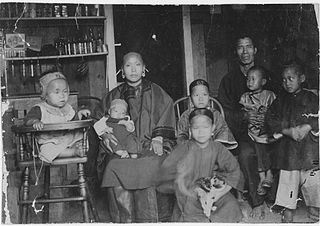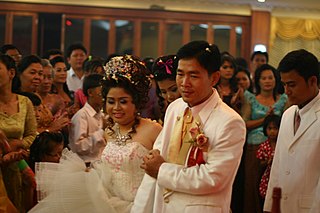
Marriage, also called matrimony or wedlock, is a culturally and often legally recognized union between people called spouses. It establishes rights and obligations between them, as well as between them and their children, and between them and their in-laws. It is nearly a cultural universal, but the definition of marriage varies between cultures and religions, and over time. Typically, it is an institution in which interpersonal relationships, usually sexual, are acknowledged or sanctioned. In some cultures, marriage is recommended or considered to be compulsory before pursuing any sexual activity. A marriage ceremony is called a wedding.

A wife is a woman in a marital relationship. A woman who has separated from her partner continues to be a wife until their marriage is legally dissolved with a divorce judgment. On the death of her partner, a wife is referred to as a widow. The rights and obligations of a wife to her partner and her status in the community and law vary between cultures and have varied over time.
A prenuptial agreement, antenuptial agreement, or premarital agreement is a written contract entered into by a couple before marriage or a civil union that enables them to select and control many of the legal rights they acquire upon marrying, and what happens when their marriage eventually ends by death or divorce. Couples enter into a written prenuptial agreement to supersede many of the default marital laws that would otherwise apply in the event of divorce, such as the laws that govern the division of property, retirement benefits, savings, and the right to seek alimony with agreed-upon terms that provide certainty and clarify their marital rights. A premarital agreement may also contain waivers of a surviving spouse's right to claim an elective share of the estate of the deceased spouse.
A widow (female) or widower (male) is a person whose spouse has died and has usually not remarried. The state of having lost one's spouse to death is termed widowhood. An archaic term for a widow is "relict," literally "someone left over". This word can sometimes be found on older gravestones. The word "widow" comes from an Indo-European root meaning "widow" and has cognates across Indo-European languages. The male form, "widower", is first attested in the 14th century, by the 19th century supplanting "widow" with reference to men.

The legal rights of women refers to the social and human rights of women. One of the first women's rights declarations was the Declaration of Sentiments. The dependent position of women in early law is proved by the evidence of most ancient systems.

Traditional Chinese marriage is a ceremonial ritual within Chinese societies that involves not only a union between spouses but also a union between the two families of a man and a woman, sometimes established by pre-arrangement between families. Marriage and family are inextricably linked, which involves the interests of both families. Within Chinese culture, romantic love and monogamy were the norm for most citizens. Around the end of primitive society, traditional Chinese marriage rituals were formed, with deer skin betrothal in the Fuxi era, the appearance of the "meeting hall" during the Xia and Shang dynasties, and then in the Zhou dynasty, a complete set of marriage etiquette gradually formed. The richness of this series of rituals proves the importance the ancients attached to marriage. In addition to the unique nature of the "three letters and six rituals", monogamy, remarriage and divorce in traditional Chinese marriage culture are also distinctive.
Thesavalamai is the traditional law of the Sri Lankan Tamil inhabitants of the Jaffna peninsula, codified by the Dutch during their colonial rule in 1707. The Thesawalamai is a collection of the Customs of the Malabar Inhabitants of the Province of Jaffna and given full force by the Regulation of 1806. For Thesawalamai to apply to a person it must be established that he is a Tamil inhabitant of the Northern Province. The Law in its present form applies to most Tamils in northern Sri Lanka. The law is personal in nature, and it is applicable mostly for property, inheritance, and marriage.

Dower is a provision accorded traditionally by a husband or his family, to a wife for her support should she become widowed. It was settled on the bride by agreement at the time of the wedding, or as provided by law.

The Chinese kinship system is among the most complicated of all the world's kinship systems. It maintains a specific designation for almost every member's kin based on their generation, lineage, relative age, and gender. The traditional system was agnatic. based on patriarchal power, patrilocal residence, and descent through the male line. Although there has been much change in China over the last century, especially after 1949, there has also been substantial continuity.

A husband is a man in a marital relationship, who may also be referred to as a spouse. The rights and obligations of a husband regarding his spouse and others, and his status in the community and in law, vary between societies and cultures, and have varied over time.

Marriage law is the legal requirements, an aspect of family law, that determine the validity of a marriage, and which vary considerably among countries.
The type, functions, and characteristics of marriage vary from culture to culture, and can change over time. In general there are two types: civil marriage and religious marriage, and typically marriages employ a combination of both. Marriages between people of differing religions are called interfaith marriages, while marital conversion, a more controversial concept than interfaith marriage, refers to the religious conversion of one partner to the other's religion for sake of satisfying a religious requirement.
Islamic Inheritance jurisprudence is a field of Islamic jurisprudence that deals with inheritance, a topic that is prominently dealt with in the Qur'an. It is often called Mīrāth, and its branch of Islamic law is technically known as ʿilm al-farāʾiḍ.

Courtship, marriage, and divorce in Cambodia are important aspects of family life. Customs vary as between rural and urban areas, with many city dwellers being influenced by western ideas. The choice of a spouse is usually undertaken by the families of young men and women, sometimes with the help of a matchmaker. A man usually marries between the ages of nineteen and twenty-five and a woman between sixteen and twenty-two.
While polygamous marriages are not legally recognized under the civil marriage laws of Namibia, a bill was successfully passed in 2003, based on the model in South Africa, which recognizes polygamous unions under customary law; affording a generous amount of benefits to polygamous unions, ranging from inheritance rights to child custody. It has been estimated that nearly one in seven women in Namibia live in polygamous relationships, which has resulted in large numbers of unmarried men.
In South Africa, marriage exists in a number of different forms, as a result of the diversity of religions and cultures in the country. A man in South Africa may have more than one spouse but a South African woman may only have one spouse. Historically the legal definition of marriage, derived from the Roman-Dutch law, was limited to monogamous marriages between opposite-sex couples. Since 1998 the law has recognised marriages, including polygynous marriages, conducted under African customary law, as well as religious laws such as Islamic law. In 2006 the South African constitutional court ruled in favour of recognizing same-sex marriage. It is currently the only country in the world to recognise both polygamy and same-sex marriages, albeit not in conjunction.

In the Sassanid Empire, the state religion Zoroastrianism created the policy that dictated relationships between men and women. Zoroastrianism set what roles women would have, the marriage practices, women's privileges in Sasanian society and influenced Islam when it arose. The moral standards, the structure of life, and the practices of the Sasanian society were found by looking at the religious writing and laws of the time. Women had legal rights, such as to own real estate, but the privileges a woman had depended on what type of wife she was, as did the restriction that were placed on her.

The Custom of Paris was one of France's regional custumals of civil law. It was the law of the land in Paris and the surrounding region in the 16th–18th centuries and was applied to French overseas colonies, including New France. First written in 1507 and revised in 1580 and 1605, the Custom of Paris was a compilation and systematization of Renaissance-era customary law. Divided into 16 sections, it contained 362 articles concerning family and inheritance, property, and debt recovery. It was the main source of law in New France from the earliest settlement, but other provincial customs were sometimes invoked in the early period.
Muslim law in Sri Lanka is one of three customary laws which is applicable to Sri Lankans who are Muslims by virtue of birth and conversion to Islam. The other two customary laws are Kandyan law and Thesavalamai. It is different from Islamic law and governs aspects of marriage, divorce custody and maintenance, having been included in the Act No. 13 of 1951 Marriage and Divorce (Muslim) Act, the Act No. 10 of 1931 Muslim Intestate Succession Ordinance and the Act No. 51 of 1956 Muslim Mosques and Charitable Trusts or Wakfs Act.
Intestate succession in South African law takes place whenever the deceased leaves property which has not been disposed of by valid testamentary instrument. In other words, the law of intestate succession applies only:











